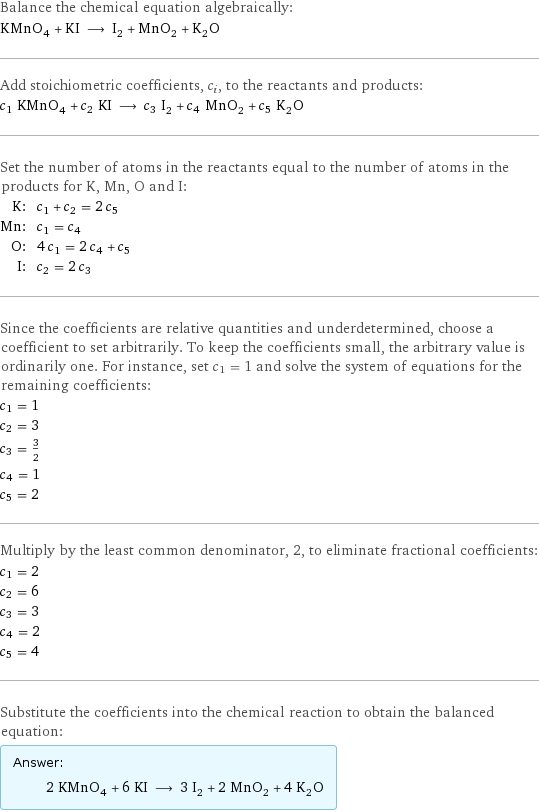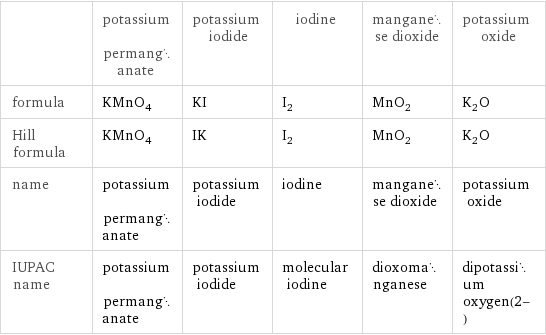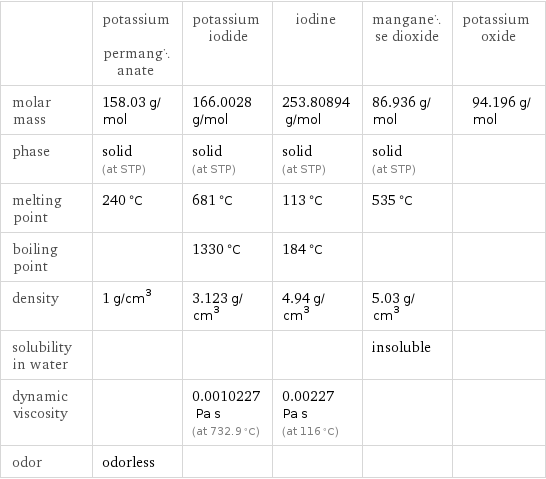Input interpretation

KMnO_4 potassium permanganate + KI potassium iodide ⟶ I_2 iodine + MnO_2 manganese dioxide + K_2O potassium oxide
Balanced equation

Balance the chemical equation algebraically: KMnO_4 + KI ⟶ I_2 + MnO_2 + K_2O Add stoichiometric coefficients, c_i, to the reactants and products: c_1 KMnO_4 + c_2 KI ⟶ c_3 I_2 + c_4 MnO_2 + c_5 K_2O Set the number of atoms in the reactants equal to the number of atoms in the products for K, Mn, O and I: K: | c_1 + c_2 = 2 c_5 Mn: | c_1 = c_4 O: | 4 c_1 = 2 c_4 + c_5 I: | c_2 = 2 c_3 Since the coefficients are relative quantities and underdetermined, choose a coefficient to set arbitrarily. To keep the coefficients small, the arbitrary value is ordinarily one. For instance, set c_1 = 1 and solve the system of equations for the remaining coefficients: c_1 = 1 c_2 = 3 c_3 = 3/2 c_4 = 1 c_5 = 2 Multiply by the least common denominator, 2, to eliminate fractional coefficients: c_1 = 2 c_2 = 6 c_3 = 3 c_4 = 2 c_5 = 4 Substitute the coefficients into the chemical reaction to obtain the balanced equation: Answer: | | 2 KMnO_4 + 6 KI ⟶ 3 I_2 + 2 MnO_2 + 4 K_2O
Structures

+ ⟶ + +
Names

potassium permanganate + potassium iodide ⟶ iodine + manganese dioxide + potassium oxide
Equilibrium constant
![Construct the equilibrium constant, K, expression for: KMnO_4 + KI ⟶ I_2 + MnO_2 + K_2O Plan: • Balance the chemical equation. • Determine the stoichiometric numbers. • Assemble the activity expression for each chemical species. • Use the activity expressions to build the equilibrium constant expression. Write the balanced chemical equation: 2 KMnO_4 + 6 KI ⟶ 3 I_2 + 2 MnO_2 + 4 K_2O Assign stoichiometric numbers, ν_i, using the stoichiometric coefficients, c_i, from the balanced chemical equation in the following manner: ν_i = -c_i for reactants and ν_i = c_i for products: chemical species | c_i | ν_i KMnO_4 | 2 | -2 KI | 6 | -6 I_2 | 3 | 3 MnO_2 | 2 | 2 K_2O | 4 | 4 Assemble the activity expressions accounting for the state of matter and ν_i: chemical species | c_i | ν_i | activity expression KMnO_4 | 2 | -2 | ([KMnO4])^(-2) KI | 6 | -6 | ([KI])^(-6) I_2 | 3 | 3 | ([I2])^3 MnO_2 | 2 | 2 | ([MnO2])^2 K_2O | 4 | 4 | ([K2O])^4 The equilibrium constant symbol in the concentration basis is: K_c Mulitply the activity expressions to arrive at the K_c expression: Answer: | | K_c = ([KMnO4])^(-2) ([KI])^(-6) ([I2])^3 ([MnO2])^2 ([K2O])^4 = (([I2])^3 ([MnO2])^2 ([K2O])^4)/(([KMnO4])^2 ([KI])^6)](../image_source/ac5af9b019f4314da7e8b3e828895f97.png)
Construct the equilibrium constant, K, expression for: KMnO_4 + KI ⟶ I_2 + MnO_2 + K_2O Plan: • Balance the chemical equation. • Determine the stoichiometric numbers. • Assemble the activity expression for each chemical species. • Use the activity expressions to build the equilibrium constant expression. Write the balanced chemical equation: 2 KMnO_4 + 6 KI ⟶ 3 I_2 + 2 MnO_2 + 4 K_2O Assign stoichiometric numbers, ν_i, using the stoichiometric coefficients, c_i, from the balanced chemical equation in the following manner: ν_i = -c_i for reactants and ν_i = c_i for products: chemical species | c_i | ν_i KMnO_4 | 2 | -2 KI | 6 | -6 I_2 | 3 | 3 MnO_2 | 2 | 2 K_2O | 4 | 4 Assemble the activity expressions accounting for the state of matter and ν_i: chemical species | c_i | ν_i | activity expression KMnO_4 | 2 | -2 | ([KMnO4])^(-2) KI | 6 | -6 | ([KI])^(-6) I_2 | 3 | 3 | ([I2])^3 MnO_2 | 2 | 2 | ([MnO2])^2 K_2O | 4 | 4 | ([K2O])^4 The equilibrium constant symbol in the concentration basis is: K_c Mulitply the activity expressions to arrive at the K_c expression: Answer: | | K_c = ([KMnO4])^(-2) ([KI])^(-6) ([I2])^3 ([MnO2])^2 ([K2O])^4 = (([I2])^3 ([MnO2])^2 ([K2O])^4)/(([KMnO4])^2 ([KI])^6)
Rate of reaction
![Construct the rate of reaction expression for: KMnO_4 + KI ⟶ I_2 + MnO_2 + K_2O Plan: • Balance the chemical equation. • Determine the stoichiometric numbers. • Assemble the rate term for each chemical species. • Write the rate of reaction expression. Write the balanced chemical equation: 2 KMnO_4 + 6 KI ⟶ 3 I_2 + 2 MnO_2 + 4 K_2O Assign stoichiometric numbers, ν_i, using the stoichiometric coefficients, c_i, from the balanced chemical equation in the following manner: ν_i = -c_i for reactants and ν_i = c_i for products: chemical species | c_i | ν_i KMnO_4 | 2 | -2 KI | 6 | -6 I_2 | 3 | 3 MnO_2 | 2 | 2 K_2O | 4 | 4 The rate term for each chemical species, B_i, is 1/ν_i(Δ[B_i])/(Δt) where [B_i] is the amount concentration and t is time: chemical species | c_i | ν_i | rate term KMnO_4 | 2 | -2 | -1/2 (Δ[KMnO4])/(Δt) KI | 6 | -6 | -1/6 (Δ[KI])/(Δt) I_2 | 3 | 3 | 1/3 (Δ[I2])/(Δt) MnO_2 | 2 | 2 | 1/2 (Δ[MnO2])/(Δt) K_2O | 4 | 4 | 1/4 (Δ[K2O])/(Δt) (for infinitesimal rate of change, replace Δ with d) Set the rate terms equal to each other to arrive at the rate expression: Answer: | | rate = -1/2 (Δ[KMnO4])/(Δt) = -1/6 (Δ[KI])/(Δt) = 1/3 (Δ[I2])/(Δt) = 1/2 (Δ[MnO2])/(Δt) = 1/4 (Δ[K2O])/(Δt) (assuming constant volume and no accumulation of intermediates or side products)](../image_source/d0f0190f54542048ae15412c97e5b324.png)
Construct the rate of reaction expression for: KMnO_4 + KI ⟶ I_2 + MnO_2 + K_2O Plan: • Balance the chemical equation. • Determine the stoichiometric numbers. • Assemble the rate term for each chemical species. • Write the rate of reaction expression. Write the balanced chemical equation: 2 KMnO_4 + 6 KI ⟶ 3 I_2 + 2 MnO_2 + 4 K_2O Assign stoichiometric numbers, ν_i, using the stoichiometric coefficients, c_i, from the balanced chemical equation in the following manner: ν_i = -c_i for reactants and ν_i = c_i for products: chemical species | c_i | ν_i KMnO_4 | 2 | -2 KI | 6 | -6 I_2 | 3 | 3 MnO_2 | 2 | 2 K_2O | 4 | 4 The rate term for each chemical species, B_i, is 1/ν_i(Δ[B_i])/(Δt) where [B_i] is the amount concentration and t is time: chemical species | c_i | ν_i | rate term KMnO_4 | 2 | -2 | -1/2 (Δ[KMnO4])/(Δt) KI | 6 | -6 | -1/6 (Δ[KI])/(Δt) I_2 | 3 | 3 | 1/3 (Δ[I2])/(Δt) MnO_2 | 2 | 2 | 1/2 (Δ[MnO2])/(Δt) K_2O | 4 | 4 | 1/4 (Δ[K2O])/(Δt) (for infinitesimal rate of change, replace Δ with d) Set the rate terms equal to each other to arrive at the rate expression: Answer: | | rate = -1/2 (Δ[KMnO4])/(Δt) = -1/6 (Δ[KI])/(Δt) = 1/3 (Δ[I2])/(Δt) = 1/2 (Δ[MnO2])/(Δt) = 1/4 (Δ[K2O])/(Δt) (assuming constant volume and no accumulation of intermediates or side products)
Chemical names and formulas

| potassium permanganate | potassium iodide | iodine | manganese dioxide | potassium oxide formula | KMnO_4 | KI | I_2 | MnO_2 | K_2O Hill formula | KMnO_4 | IK | I_2 | MnO_2 | K_2O name | potassium permanganate | potassium iodide | iodine | manganese dioxide | potassium oxide IUPAC name | potassium permanganate | potassium iodide | molecular iodine | dioxomanganese | dipotassium oxygen(2-)
Substance properties

| potassium permanganate | potassium iodide | iodine | manganese dioxide | potassium oxide molar mass | 158.03 g/mol | 166.0028 g/mol | 253.80894 g/mol | 86.936 g/mol | 94.196 g/mol phase | solid (at STP) | solid (at STP) | solid (at STP) | solid (at STP) | melting point | 240 °C | 681 °C | 113 °C | 535 °C | boiling point | | 1330 °C | 184 °C | | density | 1 g/cm^3 | 3.123 g/cm^3 | 4.94 g/cm^3 | 5.03 g/cm^3 | solubility in water | | | | insoluble | dynamic viscosity | | 0.0010227 Pa s (at 732.9 °C) | 0.00227 Pa s (at 116 °C) | | odor | odorless | | | |
Units
